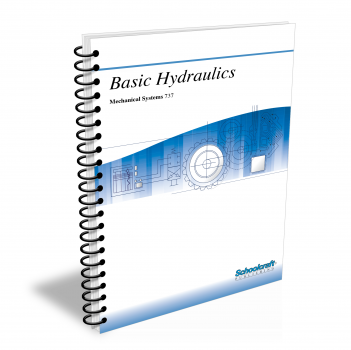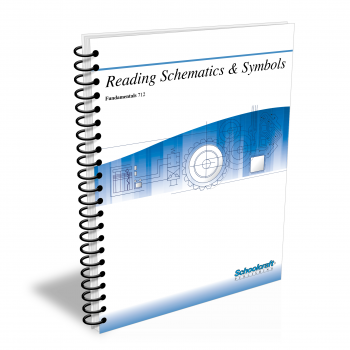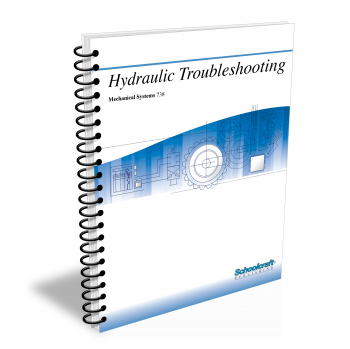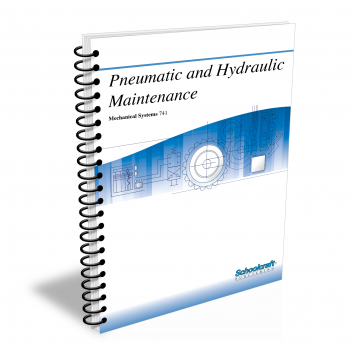Basic Hydraulics

Course Number: 737
The Basic Hydraulics textbook opens with a thorough description of hydraulic principles. Subsequent lessons then describe the various components that make up a complete system, beginning with hydraulic fluid and progressing through the various mechanical components. The textbook describes a wide variety of hydraulic cylinders and motors. This textbook is a prerequisite for the 738 textbook, Hydraulic Troubleshooting.
Does your curriculum require additional topics not included in this textbook? Build a customized version of the Basic Hydraulics textbook below.
This textbook has been recently updated
to include topics lists, objectives, & key terms for every chapter.
Recommended Contact Hours – 15
Preview a Chapter
Available Supporting Material
- Table of Contents
- Exam Copies
- Suggested Titles
Table of Contents
Chapter 1: Principles of Hydraulics
Topics: Force, weight, mass, pressure, work, power, and energy; Incompressibility; Nondiffusion; Hydrostatic pressure; Pascal's Law; Fluid power transmission; Bernoulli's principle
Learning Objectives:
- Explain the difference between absolute and gauge pressure.
- Demonstrate how power is calculated.
- Explain Pascal's Law.
- Describe the difference between laminar and turbulent flow.
- Name the main components of a hydraulic system.
Chapter 2: Hydraulic Fluids
Topics: Viscosity; Pour point; Fluid selection; Chemical properties; System contamination; Dissolved air; Foaming; Corrosion and rusting
Learning Objectives:
- List the most important properties of hydraulic fluids.
- Explain how viscosity is measured.
- Explain the meaning of the viscosity index.
- Describe the effect of fluid temperature on viscosity.
- Name the causes of corrosion and fluid oxidation.
- Identify various types of hydraulic fluids.
Chapter 3: Strainers and Filters
Topics: Contaminant removal; Strainer performance; Types of strainers; Fibrous and nonfibrous filter media; Magnetic media; Installation
Learning Objectives:
- Name contaminants found in hydraulic systems.
- Explain the difference between a strainer and a filter, and describe the main function of each.
- Describe the two basic types of filter/strainer media.
- Draw graphic symbols for strainers and filters.
Chapter 4: Reservoirs and Accumulators
Topics: Reservoir, air separation requirements; Baffles; Reservoir cooling methods and accessories; Accumulators; Schematic symbols
Learning Objectives:
- Explain the functions of fluid reservoirs.
- Explain the purpose of reservoir baffles.
- Describe various methods of counteracting high operating temperatures.
- Identify important accessories used with reservoirs.
- Demonstrate pressure ratio calculation for a differential-piston accumulator.
Chapter 5: Hydraulic Pumps
Topics: Pump varieties, functions, and selection; Gear, screw, cycloidal, vane, axial-piston, and radial-piston pumps
Learning Objectives:
- Name the main classification of hydraulic pumps.
- List factors affecting pump selection and pump performance.
- Define volumetric efficiency and overall efficiency.
- Identify the most common types of positive-displacement pumps, and describe their operation.
Chapter 6: Piping, Tubing, and Fittings
Topics: Fluid flow and velocity; Hydraulic pressure; Pressure loss; Steel pipe and fittings; Tubing and tube bending; Hoses; Hose fittings and couplings
Learning Objectives:
- Discuss the chief considerations in hydraulic line selection.
- Demonstrate how flow velocity and pressure loss are calculated.
- Explain pipe size schedules.
- Describe various types of fittings used in hydraulic systems.
- Explain the reason for using steel pipe.
- List the main advantages of tubing.
Chapter 7: Directional Control Valves
Topics: Valve classification; Automatic, two-way, check, pilot-operated, and spool valves; Hydraulic motors; NO, NC, holding valves; Symbols; Flow ratings
Learning Objectives:
- Explain the classification of directional control valves.
- Describe how manually operated valves work.
- Explain the difference between direct-acting and pilot-operated valves.
- Describe the operation of a check valve, a spool valve, a three-way valve, a four-way valve, and a rotary valve.
- Explain the difference between normally closed and normally open valves.
Chapter 8: Pressure-Control Valves
Topics: Poppet, spool, sequence, counterbalance, holding, unloading, and pressure-reducing valves; Shock suppressors; Flow-control valves
Learning Objectives:
- Explain the functions of a pressure-control valve, a pressure-relief valve, and a pressure-reducing valve.
- Describe the operation of a spool valve, a poppet valve, and a sequence valve.
- Explain the purpose of holding valves, unloading valves, and counterbalance valves.
- Name the operations performed by flow-control valves.
- Describe how pressure compensation and temperature compensation work.
Chapter 9: Hydraulic Cylinders
Topics: Double-, single-acting cylinders; Two-piston cylinders; Positional cylinders; Cylinder construction; Rings, seals, and packing; Cylinder mounting and selection; Flow capacity; Cushioning
Learning Objectives:
- Describe the purpose of a hydraulic cylinder, and explain how a double-acting cylinder works.
- Explain the difference between "pull-type" and "push-type" single-acting cylinders.
- Describe the construction of a hydraulic cylinder.
- Explain the various methods of mounting cylinders.
- Demonstrate how to calculate the flow capacity of a hydraulic cylinder.
Chapter 10: Hydraulic Motors
Topics: Performance specifications; Starting, running, and stalling torque; Volumetric efficiency; Hydraulic motor construction; Gear, vane, and piston motors
Learning Objectives:
- Explain the classification of hydraulic motors.
- Demonstrate how the torque of a hydraulic motor is calculated.
- Calculate the horsepower output of a hydraulic motor.
- Discuss cost factors and other considerations affecting motor selection.
- Describe the construction of a hydraulic motor.
- Explain the operating principles of a gear motor, a vane motor, and a piston motor.
Request Exam Copies
Exam Copies
Ready to see a copy of our textbooks? After selecting which textbooks you’d like to review for your course, you can submit your request by either logging in or creating an account so we know where to ship your exam copies. A representative from Schoolcraft will contact you to confirm and finish processing your request.
Exam copies are always free and yours to keep.
Selected Exam Copies
none selected
* Maximum of five copies can be ordered


